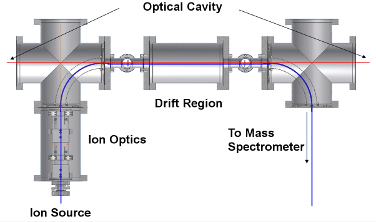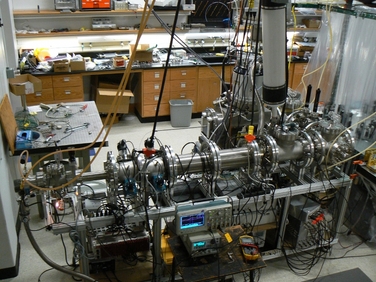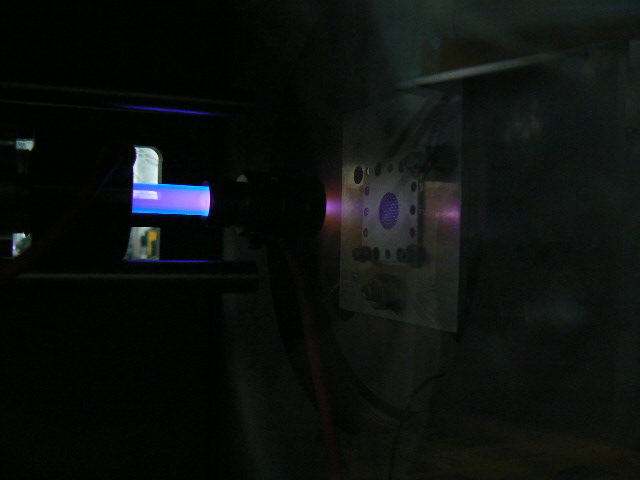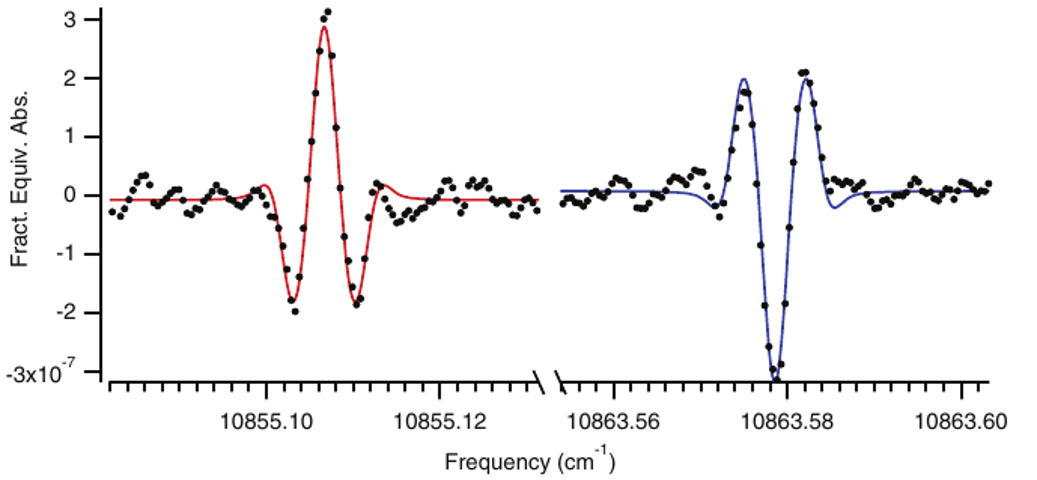SCRIBES
Sensitive, Cooled, Resolved Ion BEam Spectroscopy

A diagram of the SCRIBES instrument. Click for full size (opens in a new window/tab).
Introduction
Molecular ions play vital roles in many diverse areas of chemistry
and astronomy, and are particularly relevant to chemistry in the
interstellar medium (ISM). Because the ISM has a low number density
(~100 cm-3) and temperature (~30 K), reactions with small
barriers (such as ion/molecule reactions) dominate the chemistry.
Because spectroscopy is the only tool available for probing astronomical
environments, it is important to obtain laboratory spectra of these
ions so that they may be detected in space. Vibrational spectroscopy is
a particularly effective tool for this, as a molecule's vibrational
spectrum contains a unique fingerprint based on its structure.
Furthermore, a vibrational spectrum can be used to extract the
rotational spectrum of a molecule, which is difficult to obtain because of
difficulties in producing sufficient numbers of molecules and the microwave
search problem. With SCRIBES, we are developing cutting-edge laboratory techniques for
laser spectroscopic study of molecular ions in the gas phase under
astrophysically relevant conditions. SCRIBES consists of an ion source, a
fast ion beam, highly sensitive cavity enhanced spectroscopies, and a mass spectrometer.

The SCRIBES experiment as of 7 October 2009. The source chamber is in the background; the benders and drift region are to the right. The long tube in the foreground is the time-of-flight mass spectrometer.
Ion Source
Direct current discharges have commonly been used to produce ions for
spectroscopy. However, the ions are produced with high rotational and
vibrational temperatures. This is problematic not only because of
increased spectral congestion, but also because, for weak transitions,
the band strength is spread out over a large number of transitions
instead of only a few, making the ion more difficult to observe. To
overcome this, we are implementing a
supersonic expansion discharge source,
which will produce translationally and rotationally cold ions (<20
K). This not only solves the previously-mentioned issues, but also
allows us to observe the spectrum as it would appear in the interstellar medium.
Ion Beam
A typical plasma is only about 1x10-6 ionized, so the vast
majority of the plasma consists of un-ionized molecules. These can
complicate the spectrum by absorbing in the same region that ions of
interest absorb. In order to reduce this spectral confusion, we are
using a fast ion beam to spatially separate the ions from the neutrals
using electrostatic ion optics. An additional benefit of a fast ion
beam is a reduction in the absorption linewidth through an effect called
kinematic compression.
Spectrometer
When the ions are spatially separated from the neutrals, they are
turned and sent into a drift region, where they are available to be
probed by laser spectroscopy. We have attempted several types of cavity enhanced spectroscopies,
including continuous-wave Cavity RingDown Spectroscopy (cw-CRDS),
Cavity Enhanced Absorption Spectroscopy (CEAS), and Noise Immune Cavity Enhanced
Optical Heterodyne Molecular Spectroscopy (NICE-OHMS). Currently we use a tunable cw Ti-Sapphire
as our laser source in the near-infrared. But we also have a home-built difference frequency generation (DFG) laser
which can be used to produce mid-infrared light. A DFG laser is made by combining the continuous-wave
outputs of a Nd:YAG laser (1064 nm) and the Ti:Sapphire laser (700-900 nm) in a periodically-poled LiNbO3 nonlinear crystal.
With this laser spectrometer, we are able to achieve high sensitivity
(minimum detectable absorbance between ~1x10-7 and ~1x10-10) and high spectral resolution
(3x10-5 cm-1).

A cold cathode discharge source used to produce hot ions. It was used as a test source for aligning the ion beam.
Mass Spectrometer
When using a plasma source to produce ions for spectroscopy, it can
be difficult to determine whether the observed spectrum comes from the
ion of interest, or some other ionic species. We use a beam
modulated time-of-flight mass spectrometer (BM-TOF-MS) to identify the
species that are produced in our continuous ion source in SCRIBES. The
BM-TOF-MS device uses quickly-pulsed deflecting plates to sweep the ion beam
over a slit aperture placed near a dual micro-channel plate detector,
thereby creating a small packet of ions. The ions in this packet are
separated by mass during flight through a 1.5 meter drift region,
resulting in a mass resolution on the order of 1 amu. By recording the
mass spectrum of the ion beam, we can confirm the presence of our ion of
interest in the beam, and also use the spectrum as a feedback mechanism
for optimizing the production of that ion in the plasma. Additionally, the mass spectrometer
can give information about the beam energy of the ion beam, as well as the energy spread.
By measuring the spread of arrival times of single ions, one can determine the energy spread
of the ion beam, which corresponds to a linewidth in the spectroscopy. Knowing the beam energy allows
us to determine where lines will appear as a consequence of the Doppler-shift of the ions. Also, we have used
the mass spectrometer to diagnose the performance of the uncooled cold cathode that
produces the ions of interest. By using hydrogen as our discharge gas, we have found
that the source contains different degrees of ion collisions depending on the orientation of
the electrodes. This information is useful for determining the optimum source setup to produce
ions of various electronic and vibrational energies. Having this mass spectrometer has
proven invaluable in deducing the barriers to spectroscopy.
Highly Accurate and Precise Spectra
Traditionally, the accuracy of work in the mid-infrared is limited by the frequency standards that are used.
Wavemeters typically have an absolute accuracy of 60-200 MHz, thereby limiting the ultimate accuracy of
the measurement. This level of precision does not allow the pure rotational transitions to be inferred from the
mid-infrared measurements with sufficient precision to enable radioastronomical searches. This problem can be reduced by
using state of the art frequency measurements on the mid-infrared transitions. We do this using
a MenloSystems Optical Frequency Comb. By using a
GPS disciplined high stability crystal oscillator as our frequency reference, and a 70 MHz accuracy wavemeter,
in conjunction with the frequency comb, we are able to determine line centers on transitions to better than
1 MHz. By improving the accuracy from 60 to 1 MHz, we ultimately increase the accuracy of measurements, further allowing
for microwave observations to be enabled by mid-infrared spectroscopy.

NICE-OHMS signal of N
2+ in the fast ion beam. The black dots are the experimental data, while the smooth lines are the fit functions. The red and blue coloring correspond to the red-shifted and blue-shifted signals respectively.
Near-IR Work
Using our tunable Ti:Sapphire laser, we were able to obtain dispersion NICE-OHMS spectra of N2+ using an uncooled cold cathode source in the ion beam spectrometer. We used our optical frequency comb to precisely calibrate the spectra of N2+, determining the line center of the rest frequency to within ~8 MHz. Our calculated sensitivity was ~2x10-11 cm-1 Hz-1/2.
Mid-IR Work
After the spectrometer was optimized for N2+ spectroscopy in the near-infrared, we implemented the mid-infrared DFG system. Our system is designed to perform NICE-OHMS on various molecular ions of astrochemical interest. We tested the mid-IR capabilities of our DFG system on methane. We were able to acquire both Doppler-broadened spectra and sub-Doppler features with sensitivities of ~2x10-7 cm-1 Hz-1/2 and ~6x10-9 cm-1 Hz-1/2 respectively. This achievement represents the first ever NICE-OHMS DFG system.
Current Work
We are currently working to integrate our supersonic expansion discharge ion source into our DFG system. Initially, we plan to characterize and optimize the new source by studying HN2+. Additionally, we plan to use the optical frequency comb and an iodine cell for stabilizing the Ti:Sapphire and the Nd:YAG lasers respectively. These two steps will allow us to acquire precisely calibrated spectra with the ability to determine the line centers of the probed transitions to a high degree of accuracy. The supersonic expansion discharge source will enable us to study the supersonically cooled spectra of CH5+, C3H3+, and other nonlinear molecular ions. Following the completion of the new source, the building of SCRIBES should be complete, and will hopefully function as a powerful tool for high resolution rotationally cooled spectroscopy of molecular ions.
Related Content
Papers
| 71 |
M. W. Porambo, B. M. Siller, J. M. Pearson, and B. J. McCall
"Broadly Tunable Mid-Infrared Noise-Immune Cavity-Enhanced Optical Heterodyne Molecular Spectrometer"
Optics Letters (2012), 37, 4422-4424. |
 |
 |
| 64 |
A. A. Mills, B. M. Siller, M. W. Porambo, M. Perera, H. Kreckel, and B. J. McCall
"Ultra-Sensitive High-Precision Spectroscopy of a Fast Molecular Ion Beam"
Journal of Chemical Physics (2011), 135, 224201. |
 |
 |
| 63 |
B. M. Siller, M. W. Porambo, A. A. Mills, and B. J. McCall
"Noise Immune Cavity Enhanced Optical Heterodyne Velocity Modulation Spectroscopy"
Optics Express (2011), 19, 24822–24827. |
 |
 |
| 53 |
A. A. Mills, B. M. Siller, and B. J. McCall
"Precision Cavity Enhanced Velocity Modulation Spectroscopy"
Chemical Physics Letters (2010), 501, 1-5. |
 |
 |
| 50 |
K. N. Crabtree, C. A. Kauffman and B. J. McCall
"A Modular and Robust Continuous Supersonic Expansion Discharge Source"
Review of Scientific Instruments (2010), 81, 086103. |
 |
 |
| 48 |
B. M. Siller, A. A. Mills, and B. J. McCall
"Cavity-Enhanced Velocity Modulation Spectroscopy"
Optics Letters (2010), 35, 1266-1268. |
 |
 |
Talks
| 120 |
M. W. Porambo, J. M. Pearson, C. M. Riccardo, and B. J. McCall
"Expansion Discharge Source for Ion Beam Laser Spectroscopy of Cold Molecular Ions"
Sixty-Eighth International Symposium on Molecular Spectroscopy, The Ohio State University, Columbus, OH, 2013. |
 |
 |
| 107 |
B. M. Siller, M. W. Porambo and B. J.McCall
"Mid-IR Direct Absorption/Dispersion Spectroscopy of a Fast Ion Beam"
Sixty-Seventh International Symposium on Molecular Spectroscopy, The Ohio State University, Columbus, OH, 2012. |
 |
 |
| 106 |
M. W. Porambo, B. M. Siller, A. A. Mills, M. Perera, H. Kreckel and B. J. McCall
"Initial Development of High Precision, High Resolution Ion Beam Spectrometer in the Near-Infrared"
Sixty-Seventh International Symposium on Molecular Spectroscopy, The Ohio State University, Columbus, OH, 2012. |
 |
 |
| 105 |
B. M. Siller, M. W. Porambo and B. J. McCall
"Cavity Enhanced Velocity Modulation Spectroscopy"
Workshop on Chemical Sensing and Quantum Manipulation with Molecular Ions, Georgia Institute of Technology, Atlanta, GA, 2012. |
|
 |
| 104 |
M. W. Porambo, H. Kreckel, A. Mills, M. Perera, B. M. Siller and B. J. McCall
"High Precision, Sensitive, Near-IR Spectroscopy in a Fast Ion Beam"
Midwest Astrochemistry Meeting, University of Illinois, Urbana, IL, 2011. |
 |
 |
| 102 |
B. J. McCall
"New Approaches to High Resolution Spectroscopy of Molecular Ions"
31st International Symposium on Free Radicals, Port Douglas, Australia, 2011. |
|
 |
| 101 |
B. M. Siller, A. A. Mills, M. W. Porambo and B. J. McCall
"Cavity Enhanced Velocity Modulation Spectroscopy"
Cavity Enhanced Spectroscopy User Meeting, Queen's University, Kingston, Ontario, Canada, 2011. |
 |
 |
| 93 |
B. M. Siller, A. A. Mills, M. W. Porambo and B. J. McCall
"Noise Immune Cavity Enhanced Optical Heterodyne Velocity Modulation Spectroscopy"
Sixty-Sixth International Symposium on Molecular Spectroscopy, The Ohio State University, Columbus, OH, 2011. |
 |
 |
| 95 |
M. W. Porambo, A. A. Mills, B. M. Siller, H. Kreckel, M. Perera and B. J. McCall
"Progress and Recent Developments in Sensitive, Cooled, Resolved Ion Beam Spectroscopy (SCRIBES)"
Sixty-Sixth International Symposium on Molecular Spectroscopy, The Ohio State University, Columbus, OH, 2011. |
 |
 |
| 94 |
A. A. Mills, M. W. Porambo, B. M. Siller, B. J. McCall
"Lineshape and Sensitivity of Spectroscopic Signals of N2+ in a Positive Column Collected Using NICE-OHVMS"
Sixty-Sixth International Symposium on Molecular Spectroscopy, The Ohio State University,Columbus, OH, 2011. |
 |
 |
| 90 |
B. M. Siller, A. A. Mills, M. W. Porambo and B. J. McCall
"Cavity Enhanced Velocity Modulation Spectroscopy"
Midwest Astrochemistry Meeting, University of Illinois, Urbana, IL, 2010. |
|
 |
| 83 |
A. A. Mills, B. M. Siller and B. J. McCall
"Precision Cavity Enhanced Velocity Modulation Spectroscopy"
Sixty-Fifth International Symposium on Molecular Spectroscopy, The Ohio State University, Columbus, OH, 2010. |
 |
 |
| 80 |
B. M. Siller, A. A. Mills and B. J. McCall
"Cavity Enhanced Velocity Modulation Spectroscopy"
Sixty-Fifth International Symposium on Molecular Spectroscopy, The Ohio State University, Columbus, OH, 2010. |
 |
 |
| 81 |
A. A. Mills, B. M. Siller, H. Kreckel, M. Perera and B. J. McCall
"Towards High Resolution Cavity Enhanced Spectroscopy with Fast Ion Beams"
Sixty-Fifth International Symposium on Molecular Spectroscopy, The Ohio State University, Columbus, OH, 2010. |
 |
 |
| 71 |
H. Kreckel, A. A. Mills, M. Perera, B. M. Siller, K. N. Crabtree, C. A. Kauffman and B. J. McCall
"High Resolution Spectroscopy of Molecular Ion Beams"
239th American Chemical Society National Meeting, San Francisco, CA, 2010. |
|
 |
| 70 |
H. Kreckel, A. A. Mills, M. Perera, B. M. Siller, K. N. Crabtree, C. A. Kauffman and B. J. McCall
"SCRIBES: Sensitive, Cooled, Resolved Ion-BEam Spectroscopy"
Second Midwest Astrochemistry Meeting, University of Illinois, 2009. |
 |
 |
| 65 |
A. A. Mills, K. B. Ford, H. Kreckel, M. Perera, K. N. Crabtree and B. J. McCall
"Indirect Terahertz Spectroscopy of Molecular Ions Using Highly Accurate and Precise Mid-IR Spectroscopy"
Sixty-Fourth International Symposium on Molecular Spectroscopy, The Ohio State University, Columbus, OH, 2009. |
 |
 |
| 64 |
M. Perera, K. N. Crabtree, K. B. Ford, H. Kreckel, A. A. Mills and B. J. McCall
"Progress in the Development of an Infrared Ion Beam Spectrometer"
Sixty-Fourth International Symposium on Molecular Spectroscopy, The Ohio State University, Columbus, OH, 2009. |
 |
 |
| 47 |
A. A. Mills, K. N. Crabtree, and B. J. McCall
"Progress on the Development of an Infrared Ion Beam Spectrometer"
Sixty-Third International Symposium on Molecular Spectroscopy, Ohio State University, Columbus, OH, 2008. |
 |
 |
| 35 |
S. L. Widicus Weaver, A. A. Mills, and B. J. McCall
"Cavity Ringdown Spectroscopy of Molecular Ions in a Fast Ion Beam"
Sixty-Second International Symposium on Molecular Spectroscopy, Ohio State University, Columbus, OH, 2007. |
 |
 |
| 34 |
A. A. Mills, S. L. Widicus Weaver, and B. J. McCall
"Development of a Fast Ion Beam Spectrometer for Molecular Ion Spectroscopy"
Sixty-Second International Symposium on Molecular Spectroscopy, Ohio State University, Columbus, OH, 2007. |
 |
 |
Posters
| 23 |
M. W. Porambo, H. Kreckel, A. A. Mills, M. Perera, B. M. Siller and B. J. McCall
"Sensitive, Cooled, Resolved, Ion BEam Spectroscopy: SCRIBES"
Midwest Astrochemistry Meeting, University of Illinois, Urbana, IL, 2010. |
|
 |
| 20 |
A. A. Mills, B. M. Siller, H. Kreckel, M. Perera, M. W. Porambo and B. J. McCall
"New Approaches to Molecular Ion Spectroscopy"
Spectroscopy of Molecular Ions in the Laboratory and in Space, Kos, Greece, 2010. |
|
 |
| 14 |
K. N. Crabtree, K. B. Ford, C. A. Kauffman, H. Kreckel, A. A. Mills, M. Perera, B. M. Siller and B. J. McCall
"SCRIBES: Sensitive, Cooled, Resolved, Ion BEam Spectroscopy"
Advancing Chemical Understanding Through Astronomical Observations, Green Bank Telescope, Green Bank, WV, 2009. |
|
 |
| 11 |
A. A. Mills, H. Kreckel, M. Perera, K. N. Crabtree, B. M. Siller, K. B. Ford and B. J. McCall
"Ultrasensitive Infrared Spectroscopy of Molecular Ions"
Air Force Molecular Dynamics Contractors Meeting, San Diego, CA, 2009. |
|
 |
| 9 |
A. A. Mills, K. B. Ford, K. N. Crabtree and B. J. McCall
"High Resolution Spectroscopy of Molecular Ions: Development of an Instrument"
Inaugural Midwest Astrochemistry Meeting, University of Illinois, 2008. |
 |
 |
| 6 |
S. L. Widicus Weaver, A. A. Mills, and B. J. McCall
"Continuous-wave Cavity Ringdown Spectroscopy of Molecular Ions in a Fast Ion Beam"
American Chemical Society National Meeting, Chicago, Illinois, 2007. |
 |
 |
Other Publications
| 39 |
M. W. Porambo
"Development of a sensitive mid-infrared spectrometer for the study of cooled molecular ions "
Ph.D Thesis, University of Illinois, 2015. |
|
 |
| 33 |
B. M. Siller
"New Techniques for Sub-Doppler Spectroscopy of Molecular Ions"
Ph.D Thesis, University of Illinois, 2013. |
|
 |
| 30 |
M. W. Porambo
"Molecular Ion Spectroscopy: New Methods and the Proposed Study of H2CO+"
Research Prospectus for Preliminary Examination, University of Illinois, 2011. |
|
 |
| 28 |
A. A. Mills
"Design, Construction, and Characterization of an Ultra-sensitive, High-precision Fast Ion-Beam Spectrometer for the Study of Molecular Ions"
Ph.D. Thesis, University of Illinois, 2011. |
|
 |
| 23 |
B. M. Siller
"Cavity Enhanced Velocity Modulation Spectroscopy of C2H5+"
Research Prospectus for Preliminary Examination, University of Illinois, 2010. |
|
 |
| 20 |
K. N. Crabtree
"Design of a Continuous Supersonic Expansion Discharge Source for the Acquisition of a Rotationally-Cold Vibrational Spectrum of CH5+ with the SCRIBES Instrument"
Research Prospectus for Preliminary Examination, University of Illinois, 2009. |
|
 |
| 15 |
A. A. Mills
"Construction of the SCRIBES (Sensitive Cooled Resolved Ion BEam Spectroscopy) Instrument for the Detection of Astrochemically Important Molecular Ions"
Research Prospectus for Preliminary Examination, University of Illinois, 2007. |
|
 |
| 14 |
B. E. Brumfield
"High-Resolution Spectroscopic Studies of C60 and C6H7+: Molecules of Fundamental Spectroscopic and Astrochemical Importance"
Research Prospectus for Preliminary Examination, University of Illinois, 2007. |
|
 |




